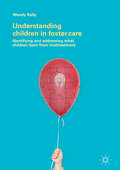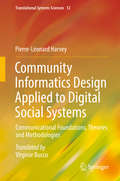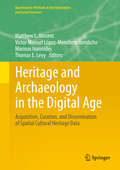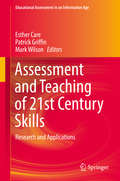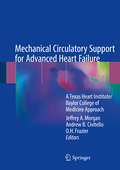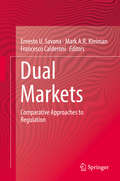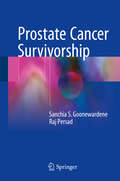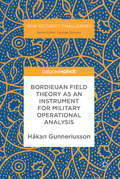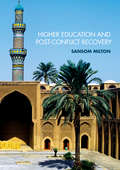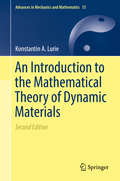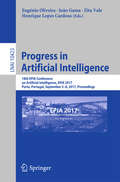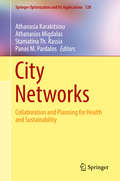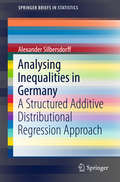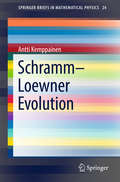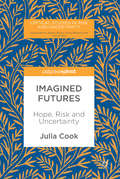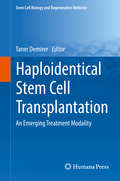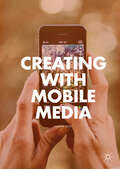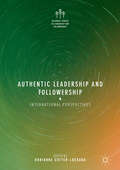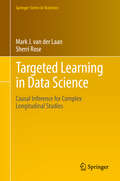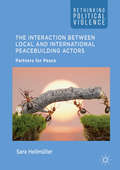- Table View
- List View
Self-Tracking
by Btihaj AjanaThis book provides an empirical and philosophical investigation of self-tracking practices. In recent years, there has been an explosion of apps and devices that enable the data capturing and monitoring of everyday activities, behaviours and habits. Encouraged by movements such as the Quantified Self, a growing number of people are embracing this culture of quantification and tracking in the spirit of improving their health and wellbeing. The aim of this book is to enhance understanding of this fast-growing trend, bringing together scholars who are working at the forefront of the critical study of self-tracking practices. Each chapter provides a different conceptual lens through which one can examine these practices, while grounding the discussion in relevant empirical examples. From phenomenology to discourse analysis, from questions of identity, privacy and agency to issues of surveillance and tracking at the workplace, this edi ted collection takes on a wide, and yet focused, approach to the timely topic of self-tracking. It constitutes a useful companion for scholars, students and everyday users interested in the Quantified Self phenomenon.
Understanding Children in Foster Care
by Wendy KellyThis book introduces the Relational Learning Framework (RLF), an assessment tool which helps foster care practitioners, social workers and foster carers to examine what foster children have learned in their early life about relationships and particularly through maltreatment. Grounded in attachment theory and drawing on cognitive theory this book will help practitioners to understand and respond to the challenging behaviour presented by these children and remove barriers to an empathic response. Early chapters provide context in a theoretical discourse on the causes and consequences of psychological and attachment difficulties for children in care, including a discussion of maltreatment and foster care. The theoretical basis of the technique will be outlined and subsequent chapters will explain how to undertake RLF including the wide-ranging practice evidence, a worked example, common themes and trouble shooting. This will be an invaluable source for clinical practitioners, social workers, foster care practitioners and foster parents who want to make sense of the complex information about children in foster care to improve their relationships. It will also provide insight into foster children's mental health and behaviour for academics and postgraduate students in related disciplines.
Community Informatics Design Applied to Digital Social Systems
by Pierre-Léonard Harvey Virginie BuccoThis book introduces a Digital Social System Praxis Framework (DSSPF) integrating Computational Media, Evolutionary Systems Thinking and Design Thinking approaches to E-transformation practice, also called Community Informatics Design (CID). The DSSPF framework is intended to create communication spaces dedicated to knowledge production and sharing for social and organizational change. It allows social systems researchers and practitioners to recognize their synergistic roles in the praxis process to shape their future through social innovation projects. This transdisciplinary text provides potential students and practitioners fundamental concepts and tools for such design. It offers resources from the Pragmatic and Systemic philosophy of science for the co-construction of social architectures and infrastructures, and multi-aspectual design methodologies by which government, organizations and civil society can learn to ethically co-design common ground. This approach provides complementary and common patterns from known methods, models, and theories of social systems interventions that could support a generic framing of large scale sociotechnical systems: digital social innovation ecosystem, living Labs, Fab Labs, enterprise collaborative networks.There will be a particular focus on understanding and addressing the dimensions that make people from different communities of practice able to communicate and collaborate through multiple digital media, design platforms, worldviews and modeling approaches.
Heritage and Archaeology in the Digital Age: Acquisition, Curation, And Dissemination Of Spatial Cultural Heritage Data (Quantitative Methods In The Humanities And Social Sciences Ser.)
by Thomas E. Levy Marinos Ioannides Matthew L. Vincent Víctor Manuel López-Menchero BendichoThis book examines how computer-based programs can be used to acquire ‘big’ digital cultural heritage data, curate, and disseminate it over the Internet and in 3D visualization platforms with the ultimate goal of creating long-lasting “digital heritage repositories.’ The organization of the book reflects the essence of new technologies applied to cultural heritage and archaeology. Each of these stages bring their own challenges and considerations that need to be dealt with. The authors in each section present case studies and overviews of how each of these aspects might be dealt with. While technology is rapidly changing, the principles laid out in these chapters should serve as a guide for many years to come. The influence of the digital world on archaeology and cultural heritage will continue to shape these disciplines as advances in these technologies facilitate new lines of research. serif">The book is divided into three sections covering acquisition, curation, and dissemination (the major life cycles of cultural heritage data). Acquisition is one of the fundamental challenges for practitioners in heritage and archaeology, and the chapters in this section provide a template that highlights the principles for present and future work that will provide sustainable models for digital documentation. Following acquisition, the next section highlights how equally important curation is as the future of digital documentation depends on it. Preservation of digital data requires preservation that can guarantee a future for generations to come. The final section focuses on dissemination as it is what pushes the data beyond the shelves of storage and allows the public to experience the past through these new technologies, but also opens new lines of investigation by giving access to these data to researchers around the globe. Digital technology promises significant changes in how we approach social sciences, cultural heritage, and archaeology. However, researchers must consider not only the acquisition and curation, but also the dissemination of these data to their colleagues and the public.Throughout the book, many of the authors have highlighted the usefulness of Structure from Motion (SfM) work for cultural heritage documentation; others the utility and excitement of crowdsourcing as a ‘citizen scientist’ tool to engage not only trained students and researchers, but also the public in the cyber-archaeology endeavor. Both innovative tools facilitate the curation of digital cultural heritage and its dissemination. Together with all the chapters in this volume, the authors will help archaeologists, researchers interested in the digital humanities and scholars who focus on digital cultural heritage to assess where the field is and where it is going.
Assessment and Teaching of 21st Century Skills: Research and Applications (Educational Assessment in an Information Age)
by Mark Wilson Patrick Griffin Esther CareRapid--and seemingly accelerating--changes in the economies of developed nations are having a proportional effect on the skill sets required of workers in many new jobs. Work environments are often technology-heavy, while problems are frequently ill-defined and tackled by multidisciplinary teams. This book contains insights based on research conducted as part of a major international project supported by Cisco, Intel and Microsoft. It faces these new working environments head-on, delineating new ways of thinking about '21st-century' skills and including operational definitions of those skills. The authors focus too on fresh approaches to educational assessment, and present methodological and technological solutions to the barriers that hinder ICT-based assessments of these skills, whether in large-scale surveys or classrooms. Equally committed to defining its terms and providing practical solutions, and including international perspectives and comparative evaluations of assessment methodology and policy, this volume tackles an issue at the top of most educationalists' agendas.
Mechanical Circulatory Support for Advanced Heart Failure
by Jeffrey A. Morgan Andrew B. Civitello O. H. FrazierThis book provides the most up to date information on every aspect of clinical care relating to patients with advanced heart failure who require mechanical circulatory support as a treatment strategy. The book begins with an extensive description of the preoperative patient selection process as well as preoperative medical optimization, including bridge to bridge strategies with short-term devices. The book then transitions into a description of a variety of surgical implantation techniques with special considerations for reoperative surgery. A chapter on intraoperative anesthesia management is specifically focused on intraoperative issues relating to MCS patients. Subsequent chapters focus on perioperative management as well as long-term management of patients on MCS, including optimization of a patient's LVAD speed. A dedicated chapter on the diagnosis of device thrombosis as well as surgical techniques and outcomes associated with device exchanges is also included. The book also summarizes the national and international outcomes data for using MCS as a bridge to transplant and destination therapy. There is also a chapter on the utility of stem cells as an adjunct technique for inducing myocardial recovery. Finally, the book has chapters on complications of MCS, management of right ventricular failure, and the future of MCS.
Dual Markets
by Ernesto U. Savona Mark A.R. Kleiman Francesco CalderoniThis comprehensive volume analyzes dual markets for regulated substances and services, and aims to provide a framework for their effective regulation. A "dual market" refers to the existence of both a legal and an illegal market for a regulated product or service (for example, prescription drugs). These regulations exist in various countries for a mix of public health, historical, political and cultural reasons. Allowing the legal market to thrive, while trying to eliminate the illegal market, provides a unique challenge for governments and law enforcement. Broken down into nine main sections, the book studies comparative international policies for regulating these "dual markets" from a historical, legal, and cultural perspective. It includes an analysis of the markets for psychoactive substances that are illegal in most countries (such as marijuana, cocaine, opiods and amphetimines), psychoactive substances which are legal in most countries and where consumption is widespread (such as alcohol and tobacco), and services that are generally regulated or illegal (such as sports betting, the sex trade, and gambling). For each of these nine types of markets, contributions focus on the relationship between regulation, the emerging illegal market, and the resulting overall access to these services. This work aims to provide a comprehensive framework from a historical, cultural, and comparative international perspective. It will be of interest to researchers in criminology and criminal justice, particularly with an interest in organized crime, as well as related fields such as sociology, public policy, international relations, and public health.
Prostate Cancer Survivorship
by Raj Persad Sanchia S. GoonewardeneThis book provides information on a range of issues related to prostate cancer survivorship, including; psychosexual care, health related quality of life, treatment, follow-up care, new psychosexual pathways, and acute and chronic co-morbidities. The book also covers the needs and challenges in survivorship care, the requirements of care, the future of survivorship care, and role of patient conferences. This book aims to give oncologists, urologists, and specialist nurses help in how to manage patients in the prostate cancer survivorship phase. This guidance is based on real life experiences handling prostate cancer survivorship, and is developed further through utilising the views of both health care professionals and patients.
Heart Rate Variability Analysis with the R package RHRV
by Constantino Antonio García Martínez Abraham Otero Quintana Xosé A. Vila María José Lado Touriño Leandro Rodríguez-Liñares Jesús María Rodríguez Presedo Arturo José Méndez PenínThis book introduces readers to the basic concepts of Heart Rate Variability (HRV) and its most important analysis algorithms using a hands-on approach based on the open-source RHRV software. HRV refers to the variation over time of the intervals between consecutive heartbeats. Despite its apparent simplicity, HRV is one of the most important markers of the autonomic nervous system activity and it has been recognized as a useful predictor of several pathologies. The book discusses all the basic HRV topics, including the physiological contributions to HRV, clinical applications, HRV data acquisition, HRV data manipulation and HRV analysis using time-domain, frequency-domain, time-frequency, nonlinear and fractal techniques. Detailed examples based on real data sets are provided throughout the book to illustrate the algorithms and discuss the physiological implications of the results. Offering a comprehensive guide to analyzing beat information with RHRV, the book is intended for masters and Ph. D. students in various disciplines such as biomedical engineering, human and veterinary medicine, biology, and pharmacy, as well as researchers conducting heart rate variability analyses on both human and animal data.
Bordieuan Field Theory as an Instrument for Military Operational Analysis (New Security Challenges)
by Håkan GunneriussonThis book is open access under a CC BY 4.0 license.This book uses Pierre Bourdieu’s field theory as a lens through which to examine military operations. Novel in its approach, this innovative text provides a better, more nuanced understanding of the modern ‘battlespace’, particularly in instances of prolonged low-intensity conflict. Formed in two parts, this book primarily explores the scope of Bourdien theory before secondly providing a detailed case study of the Yugoslavian succession war of 1990-1992. Gunneriusson suggests that although theories do not necessarily provide answers, they do help us ask better questions. This volume suggests news lines of interdisciplinary investigation that will be of interest to members of armed forces, practitioners from NGOs, and policymakers.
Higher Education and Post-Conflict Recovery
by Sansom MiltonThis book offers a critical review of higher education and post-conflict recovery. It provides the first systematic study with a global scope that investigates the role of higher education systems in conflict-affected contexts. The first part of the book analyses the long-standing neglect of higher education in post-conflict recovery, the impact that conflict can have on the sector, and efforts to rebuild and reform higher education systems affected by violent conflict. The second part of the book considers the positive and negative contributions that higher education can make to a range of areas of recovery including humanitarian action, forced displacement, post-conflict reconstruction, statebuilding, and peacebuilding. With its reasoned defence of the importance of higher education for post-conflict recovery, the book will appeal to researchers, university students, and humanitarian and development policy-makers and practitioners.
An Introduction to the Mathematical Theory of Dynamic Materials (Advances in Mechanics and Mathematics #15)
by Konstantin A. LurieThis fascinating book is a treatise on real space-age materials. It is a mathematical treatment of a novel concept in material science that characterizes the properties of dynamic materials--that is, material substances whose properties are variable in space and time. Unlike conventional composites that are often found in nature, dynamic materials are mostly the products of modern technology developed to maintain the most effective control over dynamic processes.
Design of Structural Elements with Tropical Hardwoods
by Abel O. OlorunnisolaThis book provides basic information on the design of structures with tropical woods. It is intended primarily for teaching university- and college-level courses in structural design. It is also suitable as a reference material for practitioners. Although parts of the background material relate specifically to West and East Africa, the design principles apply to the whole of tropical Africa, Latin America and South Asia. The book is laced with ample illustrations including photographs of real life wood structures and structural elements across Africa that make for interesting reading. It has numerous manual and Excel spread sheet worked examples and review questions that can properly guide a first-time designer of wooden structural elements. A number of design problems are also solved using the FORTRAN programming language. Topics covered in the thirteen chapters of the book include a brief introduction to the book, the anatomy and physical properties of tropical woods; a bri ef review of the mechanical properties of wood, timber seasoning and preservation, uses of wood and wood products in construction; basic theory of structures, and structural load computations; design of wooden beams, solid and built-up wooden columns, wood connections and wooden trusses; as well as a brief introduction to the design of wooden bridges.
Progress in Artificial Intelligence: 18th EPIA Conference on Artificial Intelligence, EPIA 2017, Porto, Portugal, September 5-8, 2017, Proceedings (Lecture Notes in Computer Science #10423)
by Zita Vale Eugénio Oliveira João Gama Henrique Lopes CardosoThis book constitutes the refereed proceedings of the 18th Portuguese Conference on Artificial Intelligence, EPIA 2017, held in Porto, Portugal, in September 2017. The 69 revised full papers and 2 short papers presented were carefully reviewed and selected from a total of 177 submissions. The papers are organized in 16 tracks devoted to the following topics: agent-based modelling for criminological research (ABM4Crime), artificial intelligence in cyber-physical and distributed embedded systems (AICPDES), artificial intelligence in games (AIG), artificial intelligence in medicine (AIM), artificial intelligence in power and energy systems (AIPES), artificial intelligence in transportation systems (AITS), artificial life and evolutionary algorithms (ALEA), ambient intelligence and affective environments (AmIA), business applications of artificial intelligence (BAAI), intelligent robotics (IROBOT), knowledge discovery and business intelligence (KDBI), knowledge representation and reasoning (KRR), multi-agent systems: theory and applications (MASTA), software engineering for autonomous and intelligent systems (SE4AIS), social simulation and modelling (SSM), and text mining and applications (TeMA).
City Networks: Collaboration and Planning for Health and Sustainability (Springer Optimization and Its Applications #128)
by Panos M. Pardalos Stamatina Th. Rassia Athanasia Karakitsiou Athanasios MigdalasThis book both analyzes and synthesizes new cutting-edge theories and methods for future design implementations in smart cities through interdisciplinary synergizing of architecture, technology, and the Internet of Things (IoT). Implementation of IoT enables the collection and data exchange of objects embedded with electronics, software, sensors, and network connectivity. Recently IoT practices have moved into uniquely identifiable objects that are able to transfer data directly into networks. This book features new technologically advanced ideas, highlighting properties of smart future city networks. Chapter contributors include theorists, computer scientists, mathematicians, and interdisciplinary planners, who currently work on identifying theories, essential elements, and practices where the IoT can impact the formation of smart cities and sustainability via optimization, network analyses, data mining, mathematical modeling and engineering. Moreover, this book includes research-based theories and real world practices aimed toward graduate researchers, experts, practitioners and the general public interested in architecture, engineering, mathematical modeling, industrial design, computer science technologies, and related fields.
Analysing Inequalities in Germany: A Structured Additive Distributional Regression Approach (SpringerBriefs in Statistics)
by Alexander SilbersdorffThis book seeks new perspectives on the growing inequalities that our societies face, putting forward Structured Additive Distributional Regression as a means of statistical analysis that circumvents the common problem of analytical reduction to simple point estimators. This new approach allows the observed discrepancy between the individuals' realities and the abstract representation of those realities to be explicitly taken into consideration using the arithmetic mean alone. In turn, the method is applied to the question of economic inequality in Germany.
Schramm–Loewner Evolution
by Antti KemppainenThis book is a short, but complete, introduction to the Loewner equation and the SLEs, which are a family of random fractal curves, as well as the relevant background in probability and complex analysis. The connection to statistical physics is also developed in the text in an example case. The book is based on a course (with the same title) lectured by the author. First three chapters are devoted to the background material, but at the same time, give the reader a good understanding on the overview on the subject and on some aspects of conformal invariance. The chapter on the Loewner equation develops in detail the connection of growing hulls and the differential equation satisfied by families of conformal maps. The Schramm-Loewner evolutions are defined and their basic properties are studied in the following chapter, and the regularity properties of random curves as well as scaling limits of discrete random curves are investigated in the final chapter. The book is aimed at graduate students or researchers who want to learn the subject fairly quickly.
Imagined Futures
by Julia CookThis book presents the findings of a recent interview-based study of how 28 young adults living in Melbourne, Australia viewed and related to both the personal and societal future. In so doing it addresses issues such as how individuals imagine the future of their society, and whether this has any bearing on the way in which they perceive and relate to their own, personal future. The respondents' future imaginings are also considered in relation to influential theoretical accounts that have sought to diagnose the character of contemporary society, and with it the future horizon. Drawing on this discussion, some alternative ways of conceptualising micro experiences of future-oriented thinking are proposed, and the role that hope can play in this process is addressed. This book will appeal to readers who are interested in the sociology of risk and uncertainty, time, and youth.
Haploidentical Stem Cell Transplantation
by Taner DemirerThis book discusses the aspects of haploidentical transplants and will shed light on the debates and questions on this burgeoning field and timely topic. Donor selection, graft failure, minimal CD34+ cell requirement, and conditioning regimens used for haploidentical transplants will be written by expert authors dealing with this type of transplants. Approximately one third of the books' chapters cover logic and basic aspects; the remaining two thirds of the book discuss clinical aspects, outcomes, and future perspectives, thus providing a comphrensive discussion of the topic. Haploidentical transplantation is extremely timely, rapidly-changing area and increasing its use will decrease the need for time-consuming, expensive, unrelated donor search. Moreover, Haploidentical Stem Cell Transplantation brings a set of clear answers to questions of feasibility, advantages over unrelated transplants, cost effectivity and outcome. .
Creating with Mobile Media
by Marsha BerryThis book investigates the convergence between locative, mobile and social media in order to show how people use mobile media for their creative practice--creative writing, photography, video and filmmaking. The central thematic focus of this book explores how mobile media has created new opportunities and contexts for creative practitioners. It draws together creative practice research with non-representational theory and digital ethnography to provide a fresh perspective on the place mobile media has in our everyday creative lives. Fictionalized and semi-fictional vignettes are used to present empirical material taken from fieldnotes and interviews to demonstrate how new forms and genres of art making have arisen because of the affordances of mobile media. The chapters in this volume have been arranged into a sequence according to the kinds of actions that make up various creative practices.
Modern Problems of Stochastic Analysis and Statistics
by Vladimir PanovThis book brings together the latest findings in the area of stochastic analysis and statistics. The individual chapters cover a wide range of topics from limit theorems, Markov processes, nonparametric methods, acturial science, population dynamics, and many others. The volume is dedicated to Valentin Konakov, head of the International Laboratory of Stochastic Analysis and its Applications on the occasion of his 70th birthday. Contributions were prepared by the participants of the international conference of the international conference "Modern problems of stochastic analysis and statistics", held at the Higher School of Economics in Moscow from May 29 - June 2, 2016. It offers a valuable reference resource for researchers and graduate students interested in modern stochastics.
Taxation in Crisis
by Dimitrios D. Thomakos Konstantinos I. NikolopoulosThis book offers a comprehensive guide to modern day taxation issues. It presents a thorough overview of many of the crucial aspects of applied taxation and current tax systems, and presents evidence that supports taxation as an important policy issue requiring immediate address globally. Contributions seek to address the core question of how to design a tax policy mix that can serve primarily efficiency, growth and possibly equity goals at a time where fiscal spending, for many economies, is not a viable option. Chapters provide a historical perspective on taxation, then go on to cover aspects of the modern theory of optimal taxation and tax design and provide valuable international perspectives on current tax practices and much required tax reforms. Empirical analysis on taxation and related economic data help the readers to understand how data-based observations and results are linked to the theory of taxation, and more importantly economic growth, before offering appropriate policy prescriptions. This book will be of interest to scholars and practitioners interested in learning more about taxation and why it matters today in the global economy.
Authentic Leadership and Followership: International Perspectives (Palgrave Studies In Leadership And Followership Ser.)
by Dorianne Cotter-LockardThis book shines a spotlight on two missing foci of authentic leadership research: international and follower perspectives. The concept of 'authenticity' has been in vogue since the times of Greek philosophy, but it wasn't until the 1990s that leadership scholars seriously began to study the topic of authentic leadership. This new collection brings together empirical research and theoretical contributions to provide insights into the follower perspectives of authentic leadership around the world. Covering topics such as leader self-awareness, gender, psychological capital, embodied leadership and followership, and unethical conduct, the book features a Foreword written by William L. Gardner, one of the original scholars on authentic leadership.
Targeted Learning in Data Science: Causal Inference For Complex Longitudinal Studies (Springer Series in Statistics)
by Mark J. van der Laan Sherri RoseThis textbook for graduate students in statistics, data science, and public health deals with the practical challenges that come with big, complex, and dynamic data. It presents a scientific roadmap to translate real-world data science applications into formal statistical estimation problems by using the general template of targeted maximum likelihood estimators. These targeted machine learning algorithms estimate quantities of interest while still providing valid inference. Targeted learning methods within data science area critical component for solving scientific problems in the modern age. The techniques can answer complex questions including optimal rules for assigning treatment based on longitudinal data with time-dependent confounding, as well as other estimands in dependent data structures, such as networks. Included in Targeted Learning in Data Science are demonstrations with soft ware packages and real data sets that present a case that targeted learning is crucial for the next generation of statisticians and data scientists. Th is book is a sequel to the first textbook on machine learning for causal inference, Targeted Learning, published in 2011.Mark van der Laan, PhD, is Jiann-Ping Hsu/Karl E. Peace Professor of Biostatistics and Statistics at UC Berkeley. His research interests include statistical methods in genomics, survival analysis, censored data, machine learning, semiparametric models, causal inference, and targeted learning. Dr. van der Laan received the 2004 Mortimer Spiegelman Award, the 2005 Van Dantzig Award, the 2005 COPSS Snedecor Award, the 2005 COPSS Presidential Award, and has graduated over 40 PhD students in biostatistics and statistics.Sherri Rose, PhD, is Associate Professor of Health Care Policy (Biostatistics) at Harvard Medical School. Her work is centered on developing and integrating innovative statistical approaches to advance human health. Dr. Rose’s methodological research focuses on nonparametric machine learning for causal inference and prediction. She co-leads the Health Policy Data Science Lab and currently serves as an associate editor for the Journal of the American Statistical Association and Biostatistics.
The Interaction Between Local and International Peacebuilding Actors
by Sara HellmüllerThis book helps to better understand how the interaction between local and international peacebuilding actors influences the outcomes of their programs. Based on the case study of Ituri in the Democratic Republic of Congo, it analyses the relationships between local and international peacebuilding actors over the long term and assesses ways to overcome the obstacles to more cooperative partnerships. Focusing on perceptions, the book nuances existing definitions of war, peacebuilding and peace and allows for a more comprehensive understanding of conflict contexts. Thereby, it contributes to the literature on peacebuilding effectiveness and makes concrete suggestions for translating these findings into practice.

